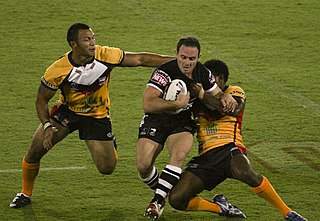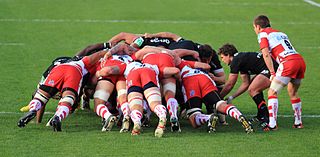| Birth name | Walter Alfred Rigney [1] | ||||||||||||
|---|---|---|---|---|---|---|---|---|---|---|---|---|---|
| Date of birth | 1 January 1898 [1] | ||||||||||||
| Place of birth | Sydney, New South Wales [1] | ||||||||||||
| Date of death | c. 1965 [1] | ||||||||||||
| Rugby union career | |||||||||||||
| |||||||||||||
Walter Alfred Rigney (1 January 1898 – c. 1965) was a rugby union player who represented Australia.

Rugby union, commonly known in most of the world simply as rugby, is a contact team sport which originated in England in the first half of the 19th century. One of the two codes of rugby football, it is based on running with the ball in hand. In its most common form, a game is between two teams of 15 players using an oval-shaped ball on a rectangular field with H-shaped goalposts at each end.

Australia, officially the Commonwealth of Australia, is a sovereign country comprising the mainland of the Australian continent, the island of Tasmania and numerous smaller islands. It is the largest country in Oceania and the world's sixth-largest country by total area. The neighbouring countries are Papua New Guinea, Indonesia and East Timor to the north; the Solomon Islands and Vanuatu to the north-east; and New Zealand to the south-east. The population of 25 million is highly urbanised and heavily concentrated on the eastern seaboard. Australia's capital is Canberra, and its largest city is Sydney. The country's other major metropolitan areas are Melbourne, Brisbane, Perth and Adelaide.
Rigney, a flanker, was born in Sydney, New South Wales and claimed a total of 3 international rugby caps for Australia.

Flanker is a position in the sport of rugby union. Each team of 15 players includes two flankers, who play in the forwards, and are generally classified as either blindside or openside flankers, numbers 6 and 7 respectively. The name comes from their position in a scrum in which they 'flank' each set of forwards. They compete for the ball – most commonly in rucks and mauls. Flankers also assist in pushing in a scrum, but are expected to detach from the scrum as soon as the ball is out to get to the play before the opposition's forwards. Flankers also participate in line-outs, either being lifted to contest or win possession, or to lift other players. Flankers are usually the key participants in the tackling process. The flankers, especially the openside, are often the fastest forwards on the team but still relied upon for tackling.






